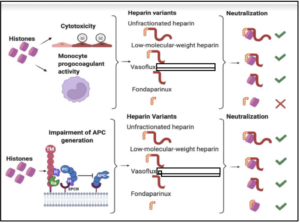TaARI investigators reveal new roles of heparin in protecting against the harmful effects of circulating histones

Investigations of the effectiveness of heparin variants as inhibitors of histones
Why did you carry out this study?
Histones are proteins that are normally found inside the nuclei of healthy cells. However, in response to infections, trauma, or other types of injury, histones can be released into the bloodstream by dying cells. Once histones are released into the bloodstream, they can cause harmful effects to the body. For example, histones can cause blood clotting, inflammation, and cell death, which can result in wide-spread organ injury. In patients with sepsis (ie. life-threatening infections), high levels of circulating histones can contribute to multi-organ failure and even death.
How did you carry out your research?
Heparin, a commonly-used blood thinner, is best known for its abilities to inactivate the blood clotting cascade. Beyond its role as a blood thinner, heparin has been shown to have other protective effects including dampening inflammation. In this study, we compared the ability of four different heparin variants to neutralize the harmful effects of histones. We studied unfractionated heparin (a large heparin), dalteparin (a medium-sized heparin), Vasoflux (a medium-sized heparin that lacks blood-thinner activity), and fondaparinux (an ultra-small heparin).
What was your most important discovery?
In this study, we showed that heparin can bind tightly to histones and can neutralize their harmful effects. In particular, heparin exerts protective effects by (1) preventing histones from killing blood vessel endothelial cells, (2) preventing histones from increasing tissue factor and phosphatidylserine expression on blood monocytes, and (3) preventing histones from inactivating natural blood thinners. We also showed that the ability of heparin to neutralize the cell-killing and blood-clotting effects of histones is size-dependent and independent of its anticoagulant activities. In contrast, all four heparins were able to neutralize histone-mediated inactivation of natural anticoagulants.
How does this research advance the field?
These studies have identified the structural components of heparin that are required to neutralize the harmful effects of circulating histones. The study also suggests that heparin variants may have therapeutic potential in the treatment of diseases associated with high levels of histones such as sepsis and disseminated intravascular coagulation (DIC).
Visual abstract of the publication

Related News
News Listing
December 15, 2023
